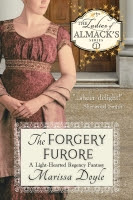Here’s another post in our
ongoing series on Regency fabrics.
As I have in previous posts, I’ll be examining actual fabric samples glued into several earlier editions of Ackermann’s Repository, samples supplied by the manufacturers and published by Ackermann in order to boost the British cloth-making industry at a time when exporting British goods to Europe was almost impossible because of the Napoleonic war. I'll give you a close-up scan of each sample, the published description if available, and my own observations of the color, weight, condition, and similarity to present-day materials, to give you as close a picture as possible of what these fabrics are like.
As I have in previous posts, I’ll be examining actual fabric samples glued into several earlier editions of Ackermann’s Repository, samples supplied by the manufacturers and published by Ackermann in order to boost the British cloth-making industry at a time when exporting British goods to Europe was almost impossible because of the Napoleonic war. I'll give you a close-up scan of each sample, the published description if available, and my own observations of the color, weight, condition, and similarity to present-day materials, to give you as close a picture as possible of what these fabrics are like.
Today’s four samples are from
the August 1811 issue of Ackermann’s Repository.
The overall condition of my copy is good: the page itself is most free of
foxing and toning, though one of the samples is a little worse for the two
hundred plus years since it was woven, and two have lost their color to a greater or lesser degree.
Here we go!
No. 1. A royal regency leno, for evening or full dress, calculated for
the Turkish robes and Roman tunics now so fashionable in elegant circles. It
should be worn over white satin, or sarsnet; and embellished with ornaments of
pearl, diamonds, white cornelian, or the satin bead. This elegant article is
furnished by Harris, Moody, and Co. Pall-Mall.
My comments: This is an attractively airy net style of fabric,
elaborately woven of lovely silky thread in dark green, yellow, and dusty pink.
While it’s mostly made of air, the style of weaving and heft to the threads
gives it some weight. I do wish more Ackermann prints showed dresses made from
the fabrics they advertised; it would be most instructive to see just what was
done with a fabric like this, worn over white satin. I think I would have been
terrified of catching it on jewelry or on something else and tearing the
you-know-what out of it.
No. 2. A dove-coloured imperial gauze, adapted for the same order of
costume, and to which the same jewellery ornaments are appropriate. Trimmings
of fine lace, with decorations of wreaths and bouquets for the hair and bosom,
are also becoming appendages to this neat and elegant article, which is
furnished by Messrs. Coopers, Pall-Mall.
My comments: Another woven net, this time of all one color. This
one feels a little less substantial than the first, despite its greater
opacity. It would be charming as an overdress; I wonder if it was made up with
the stripes oriented in the vertical or horizontal?
No. 3. A celestial blue penciled muslin, adapted for the intermediate
order of dress. It is either made high, with a trimming of narrow lace round
the throat, or formed in a low square bosom, finished with white embossed satin
ribbon. With each the long sleeve is to be preferred, in this as in most other
muslin articles.
My comments: Um...celestial blue? This sample has clearly suffered;
the dye is gone, though the feathery little random pattern printed on has
survived...and after a quick look around on the interwebz, mine is not the only
one to have suffered. It’s not easy to say much about it as it seems to have
been glued entirely down on the page, but it is a very loosely (if evenly)
woven fabric.
No. 4. A pink muslin, with embossed green spot. This animated article
is confined to the more youthful females, to whom it is most becomingly
adapted. It should invariably be worn over white sarsnet, fine glazed cambric,
or satin; and should be formed in the most plain and simple manner. No
jewellery ornaments but white can be admitted to blend with this material, nor
any but white flowers to be worn in the hair.
The last two articles are furnished by Messrs. T. and J. Smith, 43,
Tavistock-street, Covent Garden.
My comments: Oh my goodness, more polka dots! Interesting that this
fabric is only recommended for young women... The dots have faded to a not-very-attractive
khaki brown, and look almost applied—as if someone plopped little blobs of
paint onto the fabric at regular intervals. Like number three, this is a very
open-weave muslin, but the threads are of fine, uniform gauge. I suspect the pink may have once been more intense, not the pale dusty pink of today. This must have
once been a very cheerful sort of “article.”
Any thoughts on this month’s
fabrics?










No comments:
Post a Comment